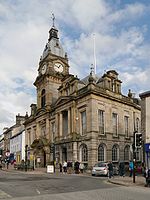Kentrigg

Kentrigg is a northern suburb of Kendal, Cumbria, England. By road, Kentrigg is located 1.2 miles (1.9 km) north of the centre of Kendal and 1.4 miles (2.3 km) southeast of Burneside. It contains the Carus Green Golf Club, which separates it from Burneside just to the northwest. Across the River Kent to the east is the Shap Road Industrial Estate, north of the district of Mintsfeet and the Mintsfeet Industrial Estate which marks the southeastern side of Kentrigg. The area contains a number of cottages which are let out to tourists. Helsfell Hall was the seat of the Briggs family which dominated the area in the 16th and 17th centuries up to the English Civil War. The old hall today is a Grade II listed building. 109 Burneside Road, also known as Aikrigg End, is a Grade II listed building, dated to the 18th and early 19th century. Kendal Fell lies to west of Kentrigg.
Excerpt from the Wikipedia article Kentrigg (License: CC BY-SA 3.0, Authors, Images).Kentrigg
Mint Bridge Road,
Geographical coordinates (GPS) Address Phone number Website Nearby Places Show on map
Geographical coordinates (GPS)
| Latitude | Longitude |
|---|---|
| N 54.341 ° | E -2.745 ° |
Address
Kendal Nutricare
Mint Bridge Road
LA9 6NL , Mintsfeet
England, United Kingdom
Open on Google Maps










